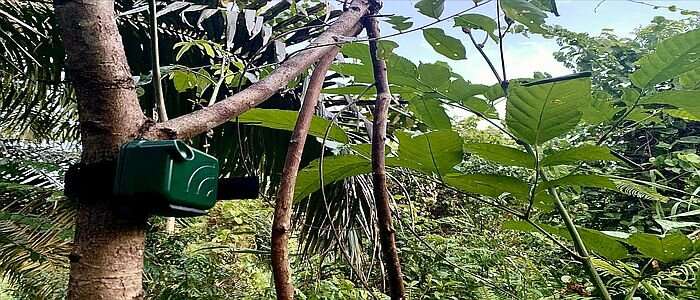This article has been reviewed according to Science X's editorial process and policies. Editors have highlighted the following attributes while ensuring the content's credibility:
fact-checked
peer-reviewed publication
trusted source
proofread
Low-cost microphones could be used to help track infectious disease risks in the wild

Researchers have shown how sounds recorded by low-cost microphones could be used to help track infectious disease risks in the rainforest and in other rapidly changing landscapes.
The study—published in Trends in Parasitology and led by the University of Glasgow—discusses how listening to the sounds of an ecosystem can inform our understanding of factors that drive the spread of disease between animals and people.
The findings are the result of a partnership between researchers from the University of Glasgow, Danau Girang Field Center in Malaysia and Rainforest Connection, an NGO which uses sound recording to monitor endangered species and send real-time alerts to prevent poaching and illegal logging in the rainforests.
To track illegal activity, Rainforest Connection uses microphones to detect human noise in the forest—not specifically speech, but listening for sounds of activity like chainsaws, gunshots, or movement through the forest.
The researchers describe how this acoustic monitoring—a cost-effective, non-invasive tool—could also be effectively used to strengthen early warning systems and improve disease surveillance.
By recording the sounds that animals make, researchers can detect changes in wildlife that could impact human disease risk; for example, tracking the changes in frequency of animal calls to identify mass mortality in wildlife due to a disease outbreak.
Acoustic data could be used to detect changes in the location or behaviors of animals in areas where zoonotic diseases (like malaria, yellow fever, rabies, trypanosomiasis and Rift Valley fever) exist and could pose a risk to other humans and animals. While acoustic monitoring won't replace existing field-based methods used to track disease risk, the researchers believe it could be a novel and useful tool when used in combination with current methods.

Passive acoustic monitoring is typically used in wildlife conservation. It is used to investigate population dynamics and behavioral trends of animals that make noise—including sound we cannot hear, like echolocation.
Working with Danau Girang Field Center in Malaysian Borneo, this study demonstrated how acoustic monitoring can be used to monitor the spread of zoonotic malaria from monkeys to mosquitoes to people.
For mosquito-borne diseases such as malaria, detection of human activity at times when mosquitos are most active could indicate heightened disease risk and be used to identify where people are exposed to infectious mosquitoes. Within the Malaysian rainforest and plantation areas, researchers have now set up an acoustic monitoring grid to track when monkeys are moving into areas with mosquitos.
In areas experiencing extensive deforestation and intensive agriculture, patterns of disease risk are changing rapidly. Researchers discuss how, by placing acoustic devices across different landscapes—from virgin jungle to oil palm plantations—we can begin to unpick the links between land use and human health.
Emilia Johnson, from the University of Glasgow's School of Biodiversity, One Health and Veterinary Medicine, said, "Emerging infectious diseases pose a significant burden on global public health, and there is a need to better understand diseases that crop up at the boundaries where human activity and wildlife habitats meet.
"Sound recording provides an opportunity to collect and analyze useful data in real-time and over very broad scales; in this way, acoustic surveys can complement existing surveillance methods and offer important new insight into the dynamic ecosystems that underpin infectious disease epidemiology."
The study, "Applications and Advances in Acoustic Monitoring for Infectious Disease Epidemiology," is published in Trends in Parasitology.
More information: Emilia Johnson et al, Applications and advances in acoustic monitoring for infectious disease epidemiology, Trends in Parasitology (2023). DOI: 10.1016/j.pt.2023.01.008
Journal information: Trends in Parasitology
Provided by University of Glasgow


















